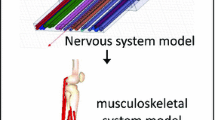Abstract
Motion control of musculoskeletal systems for functional electrical stimulation (FES) is a challenging problem due to the inherent complexity of the systems. These include being highly nonlinear, strongly coupled, time-varying, time-delayed, and redundant. The redundancy in particular makes it difficult to find an inverse model of the system for control purposes. We have developed a control system for multiple input multiple output (MIMO) redundant musculoskeletal systems with little prior information. The proposed method separates the steady-state properties from the dynamic properties. The dynamic control uses a steady-state inverse model and is implemented with both a PID controller for disturbance rejection and an artificial neural network (ANN) feedforward controller for fast trajectory tracking. A mechanism to control the sum of the muscle excitation levels is also included. To test the performance of the proposed control system, a two degree of freedom ankle–subtalar joint model with eight muscles was used. The simulation results show that separation of steady-state and dynamic control allow small output tracking errors for different reference trajectories such as pseudo-step, sinusoidal and filtered random signals. The proposed control method also demonstrated robustness against system parameter and controller parameter variations. A possible application of this control algorithm is FES control using multiple contact cuff electrodes where mathematical modeling is not feasible and the redundancy makes the control of dynamic movement difficult.
Similar content being viewed by others
Abbreviations
- FES:
-
Functional electrical stimulation
- MIMO:
-
Multiple input multiple output
- ANN:
-
Artificial neural network
- MLP:
-
Multi-layer perceptron
References
Abbas JJ, Triolo RJ (1997) Experimental evaluation of an adaptive feedforward controller for use in functional neuromuscular stimulation systems. IEEE Trans Rehabil Eng 5: 12–22
Adamczyk MM, Crago PE (2000) Simulated feedforward neural network coordiantion of hand grasp and wrist angle in a neuroprosthesis. IEEE Trans Rehabil Eng 8: 297–304
Anderson FC, Pandy MG (2001) Static and dynamic optimization solutions for gait are practically equivalent. J Biomech 34: 153–161
Chang G-C, Lub J-J, Liao G-D, Lai J-S, Cheng C-K, Kuo B-L, Kuo T-S (1997) A neuro-control system for the knee joint position control with quadriceps stimulation. IEEE Trans Rehabil Eng 5: 2–11
Crago PE, Peckham PH, Thrope GB (1980) Modulation of muscle force by recruitment during intramuscular stimulation. IEEE Trans Biomed Eng 27: 679–684
Delp SL (1990) Surgical simulation: a computer graphics system to analyze and design musculoskeletal reconstructions of the lower limb. Ph.D Dissertation, Stanford
Ferrarin M, Palazzo F, Riener R, Quintern J (2001) Model-based control of fes-induced single joint movements. IEEE Trans Neural Syst Rehabil Eng 9: 245–257 (see also IEEE Trans. Rehabil Eng)
Hogan N (1984) Adaptive control of mechanical impedance by coactivation of antagonist muscles. IEEE Trans Automat Control 29: 681–690
Jordan MI, Rumelhart DE (1992) Forward models—supervised learning with a distal teacher. Cogn Sci 16: 307–354
Karniel A, Inbar GF (2000) Human motor control: learning to control a time-varying nonlinear, many-to-one system. IEEE Trans Syst Man Cybern Part C Appl Rev 30: 1–11
Karniel A, Meir R, Inbar GF (2001) Best estimated inverse versus inverse of the best estimator. Neural Netw 14: 1153–1159
Katayama M, Kawato M (1993) Virtual trajectory and stiffness ellipse during multijoint arm movement predicted by neural inverse models. Biol Cybern 69: 353–362
Kawato M, Gomi H, Katayama M, Koike Y (1993) Supervised learning for coordinative motor control. In: Proceedings of the third NEC research symposium, pp 126–161
Kurosawa K, Futami R, Watanabe T, Hoshimiya N (2005) Joint angle control by fes using a feedback error learning controller. IEEE Trans Neural Syst Rehabil Eng 13: 359–371
Pandy MG (2001) Computer modeling and simulation of human movement. Annu Rev Biomed Eng 3: 245–273
Peckham P, Knutson J (2005) Functional electrical stimulation for neuromuscular applications. Annu Rev Biomed Eng 7: 327–360
Perreault EJ, Heckman CJ, Sandercock TG (2003) Hill muscle model errors during movement are greatest within the physiologically relevant range of motor unit firing rates. J Biomech 36: 211–218
Previdi F, Carpanzano E (2003) Design of a gain scheduling controller for knee-joint angle control by using functional electrical stimulation. IEEE Trans Control Syst Technol 11: 310–324
Qi H, Tyler DJ, Durand DM (1999) Neurofuzzy adaptive controlling of selective stimulation for fes: a case study. IEEE Trans Rehabil Eng 7: 183–192 (see also IEEE Trans Neural Syst Rehabil)
Riener R, Quintern J, Schmidt G (1996) Biomechanical model of the human knee evaluated by neuromuscular stimulation. J Biomech 29: 1157–1167
Riess J, Abbas JJ (2000) Adaptive neural network control of cyclic movements using functional neuromuscular stimulation. IEEE Trans Rehabil Eng 8: 42–52 (see also IEEE Trans Neural Syst Rehabil)
Shue G-H, Crago PE (1998) Muscle-tendon model with length history-dependent activation–velocity coupling. Ann Biomed Eng 26: 369–380
Weiss PL, RE K, Hunter IW (1986) Position dependence of ankle joint dynamics. II. Active mechanics. J Biomech 19: 737–751
Zajac FE (1989) Muscle and tendon: properties, models, scaling, and application to biomechanics and motor control. Crit Rev Biomed Eng 17: 359–411
Author information
Authors and Affiliations
Corresponding author
Rights and permissions
About this article
Cite this article
Park, H., Durand, D.M. Motion control of musculoskeletal systems with redundancy. Biol Cybern 99, 503–516 (2008). https://doi.org/10.1007/s00422-008-0258-5
Received:
Accepted:
Published:
Issue Date:
DOI: https://doi.org/10.1007/s00422-008-0258-5



